Guidance for the Reduction of Plastic Waste in Meetings and Events
On this page
- 1. Background
- 2. Our commitment
- 3. Purpose and application of the guidance
- 4. Guidance for organizers
- Appendix A: environmentally friendly alternatives to single-use products
- Appendix B: working with external hosts and suppliers
- Appendix C: meetings and events summary report template
- Appendix D: definitions in relation to this guidance
- Appendix E: recycling and composting facilities declaration
- Appendix F: guide to the recyclability of different plastics
1. Background
-
In this section
Plastics are part of the everyday lives of most Canadians and provide many social, economic and environmental benefits. Over the past 70 years, plastics production has increased more than any other manufactured material because of the unrivalled functionality, durability and low cost of plastics. Plastics are used in a wide variety of applications, including:
- packaging and single-use items
- building and construction materials
- vehicles
- textiles
- appliances
- electronics
- other end uses
Plastic pollution is found across Canada and around the world, on land, and in our oceans, lakes and waterways. Some of the ways we currently use and dispose of plastics pose a threat to the health of our environment. Single-use plastics, in particular, are a major component of marine litter. They make up a majority of the most commonly found items, known as the dirty dozen, on Canadian shorelines during cleanup activities.
The current approach to plastics use and end-of-life management also represents a significant loss of value, resources and energy. By making changes across the whole life cycle of plastics, we can keep this valuable resource in our economy and out of landfills and the environment.
Reducing plastic waste, marine litter and plastic pollution is a priority for the Government of Canada. Canada has shown leadership on the international stage through a variety of initiatives, including championing the development of the Ocean Plastics Charter in 2018 during our G7 presidency. The charter establishes targets and actions to reduce plastic waste and marine litter and move toward a more sustainable approach to producing, using and managing plastics.
The Government of Canada is working with provinces and territories through the Canadian Council of Ministers of the Environment (CCME) to reduce plastic waste and pollution. In November 2018, Canadian Environment Ministers approved, in principle, a Canada-wide Strategy on Zero Plastic Waste, which outlines a vision to keep all plastics in the economy and out of landfills and the environment. The strategy identifies 10 areas of action, using a life-cycle approach, to change how plastic products are designed, produced, used, recycled and recovered.
In June 2019, Canada’s environment ministers approved the first phase of an action plan that outlined the actions that governments will take in six priority areas:
- extended producer responsibility
- single-use and disposable plastic products
- national performance requirements and standards
- incentives for a circular economy
- infrastructure and innovation investments
- public procurement and green operations
Phase 2, coming in 2020, will identify actions to:
- improve consumer, business and institutional awareness
- reduce waste and pollution from aquatic activities
- advance science
- capture and clean up debris in the environment
- contribute to global action
To contribute to the Strategy on Zero Plastic Waste and the Ocean Plastics Charter, the Government of Canada is taking major steps to reduce plastic pollution and drive ambitious action by governments and businesses across the country. We are, for instance:
- working with provinces and territories to develop consistent, extended producer responsibility programs
- investing in innovative Canadian technologies and global solutions to address plastic pollution, including providing over $10 million to small and medium-sized businesses to develop solutions to reduce plastic waste that are made in Canada
- reducing plastic waste from federal operations, which is described in detail in this document
- supporting community-led action and citizen-science activities
- working with industry to prevent and retrieve abandoned, lost or discarded fishing gear
- accelerating research along the life cycle of plastics and its impacts on human and ecological health
Canada is also taking action through its ambitious Greening Government Strategy, which commits to government operations that are low carbon, resilient and green. On September 21, 2018, the Government of Canada further committed to additional steps, consistent with the waste-management elements of the Greening Government Strategy, to better manage the use and disposal of plastics in its own operations. This document is one part of the overall approach to reduce plastic waste.
For more information on the Government of Canada’s zero plastic waste agenda, consult toward zero plastic waste.
Actions on plastic waste in federal operations
The government has committed to:
- increase plastic waste diversion
- reduce the unnecessary use of single-use plastics in operations, meetings and events
- procure sustainable plastic products
2. Our commitment
-
In this section
This guidance relates to the Government of Canada’s actions on plastic waste in federal operations, which were set out in 2018. The guidance is focused on the following two commitments:
- to divert at least 75% of plastic waste from federal operations by 2030
- to eliminate the unnecessary use of single-use plastics in government operations, events and meetings
This guidance document addresses events and meetings.
2.1 What are our main objectives?
By reducing and managing plastic waste from events and meetings, we are:
- supporting the new Government of Canada target of diverting at least 75% of plastic waste from federal operations by 2030
- supporting the Greening Government Strategy’s commitment to divert at least 75%, by weight, of all non-hazardous operational waste by 2030
- reducing plastic pollution
Note that reducing plastic waste is only one consideration in reducing the overall environmental footprint of meetings and events. The GCpedia page on employee mobilization includes a link to the Green Meetings Guide (accessible only on the Government of Canada network), which provides advice on other important environmental considerations, such as energy use, water use and waste materials.
In 2016, about 29,000 tonnes of plastic waste was littered into our environment in Canada – that is as heavy as almost 300 blue whales! Learn more by consulting the page on zero plastic waste: the need for action.
3. Purpose and application of the guidance
-
In this section
- 3.1 What is the purpose of this guidance?
- 3.2 When will the guidance be updated?
- 3.3 Who does this apply to?
- 3.4 How will this guidance be implemented?
- 3.5 How will progress be measured?
- 3.6 What meetings and events are covered by this guidance?
- 3.7 What products are covered by this guidance?
- 3.8 What is necessary use?
- 3.9 Prioritizing accessibility
- 3.10 A hierarchy for reducing waste from single-use items
3.1 What is the purpose of this guidance?
The purpose is to inform employees in the federal government about how to increase plastic waste diversion and eliminate the unnecessary use of single-use plastic items at federal meetings and events in order to meet the Government of Canada’s commitments.
3.2 When will the guidance be updated?
This guidance will be reviewed and revised periodically in light of significant innovation or evidence-based research that would lead to changes in best practices for using, managing and recovering value from single-use plastic items.
3.3 Who does this apply to?
This guidance applies to all federal departments and agencies (referred to as “departments”). Effective September 21, 2018, all departments are required to work toward:
- increasing plastic waste diversion
- avoiding the unnecessary use of single-use items
- promoting responsible use of plastics at meetings and events
3.4 How will this guidance be implemented?
This guidance may be implemented differently depending on a department’s structure and activities. Organizers of events and meetings should consult section 4.0 of this document.
3.5 How will progress be measured?
The performance indicator related to this commitment will be the plastic waste diversion rate, established via regular departmental waste audits.
The 2019 to 2022 Federal Sustainable Development Strategy includes the Government of Canada’s commitments to reduce plastic waste.
Federal organizations should be prepared to report on their implementation activities through their Departmental Sustainable Development Strategy.
Refer to subsection 4.2.2 of this document for suggested approaches to monitoring and reporting on related actions.
For more information, contact Greening-Vert@tbs-sct.gc.ca.
3.6 What meetings and events are covered by this guidance?
This guidance covers all meetings and events organized by the Government of Canada, including:
- staff and team meetings
- seasonal festivities
- charitable, outreach and fundraising activities
- external stakeholder consultations and meetings
- conferences of any size and duration (held either within government-owned or leased buildings or within privately or commercially owned buildings)
Events delivered through a contract with the Government of Canada are included in this guidance.
Events funded through grants and contributions are not within the scope of this guidance. However, departments could apply relevant parts of this guidance to such events.
3.7 What products are covered by this guidance?
This guidance covers all single-use or disposable plastics used during meetings and events. Single-use plastics are products and packaging that:
- contain plastics
- are intended to be used only once or for a short period of time before they are thrown away or recycled
Plastic straws, utensils, balloons, plastic packaging and plastic or polystyrene foam containers are all examples of single-use plastics. Refer to section 4.0 for a more comprehensive list.
The Government of Canada’s commitments to reduce plastic waste are aligned with the Ocean Plastics Charter.
3.8 What is necessary use?
In some cases, single-use plastics may be necessary for accessibility, health, safety or security reasons. For example, some people may need to use straws to drink, and the use of sterile containers or bottled water may be necessary for health or in an emergency. In such situations, single-use plastic may be the preferred option. If so, it is important to ensure that the single-use plastic items used can be collected and recycled locally.
In other situations, many single-use products can be avoided entirely or replaced by more reusable, recyclable, or compostable alternatives that have a lower environmental impact.
3.9 Prioritizing accessibility
For all initiatives to reduce plastic waste, departments must take into consideration health, safety and accessibility requirements. Alternatives that serve the accessibility and health needs of all meeting participants should be available before a product is removed from your event. If acceptable alternatives are not available, then you should ensure that single-use plastic products continue to be available for meeting participants who require them.
3.10 A hierarchy for reducing waste from single-use items
Figure 1: hierarchy to reduce waste from single-use items shows the waste-management hierarchy for single-use items. The hierarchy is designed for all single-use items, whether they are made of plastic, glass, paper, metal or another material.
The hierarchy provides guidance to help you avoid the unnecessary use of single-use items during your event and to select environmentally friendly alternatives that will reduce waste. It presents four opportunities to reduce waste, from highest to lowest priority:
- avoid or reduce
- use a reusable item
- use a recyclable or compostable item
- dispose the item responsibly
Each of these levels is explored in more detail further on.
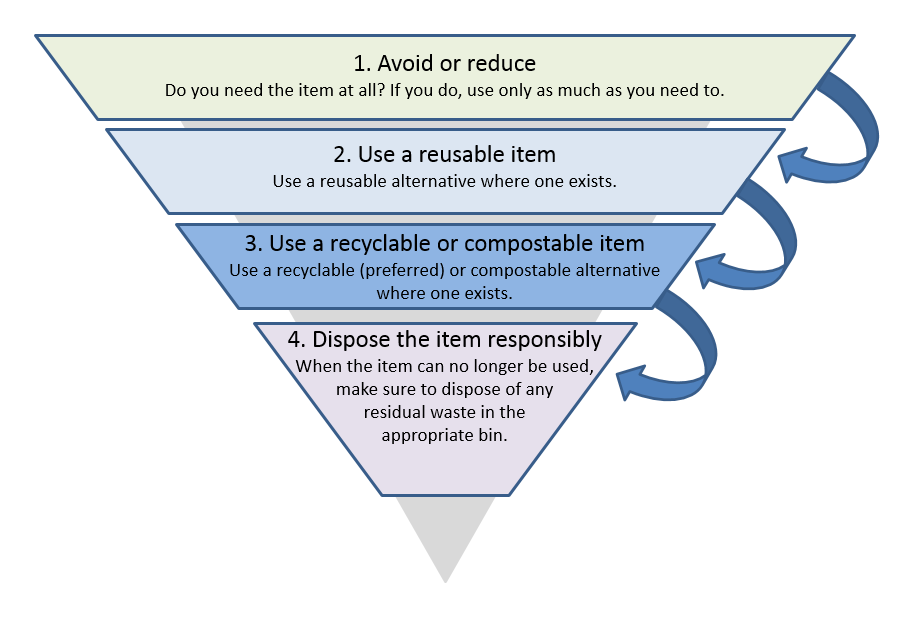
3.10.1 Avoid or reduce
The preferred option at the top of the hierarchy is to avoid unnecessary single-use items (for example, there is no need for cutlery of any sort if you are serving finger food). If it is not feasible to avoid the item entirely, plan to use only what is needed for your meeting and move down the hierarchy.
3.10.2 Reusable
The next best option is to replace a single-use item with a reusable, environmentally friendly alternative. For example, you can work with your facility or caterer to provide reusable cups, plates and utensils made of any material. Consider assembling a “dish library” – a collection of reusable tableware (plates, bowls, cutlery) that can be borrowed by meeting or event organizers.
3.10.3 Recyclable or compostable
The third choice is to select a single-use product that can be recycled or composted. You should check with your facility or service provider to determine what recycling and composting services they can provide. Facilities managers should be asked to complete Appendix E: recycling and composting facilities declaration to record the waste-management services available.
Each municipality has its own recycling program and may accept different items. Private contractors may also have different restrictions. In general, while plastic bottles and food packaging containers are accepted by most programs across Canada, most other single-use plastic items (for example, coffee cups and plastic utensils) are not. Appendix F: guide to the recyclability of different plastics provides information about what is recyclable.
Composting facilities also tend to have restricted options for products that contain plastics and plastic-coated materials (for example, coffee cups) even if those plastics are certified as compostable. Refer to Appendix D: definitions in relation to this guidance and Appendix F: guide to the recyclability of different plastics for more details. Few municipal composting facilities currently accept compostable or biodegradable plastics. Therefore, you should check that your venue has access to an industrial composting facility that accepts these materials before opting to use them. In general, before using compostable plastic materials, it is important to secure arrangements with a facility to collect and process them.
For more information on new plastics (that is, biodegradable and compostable plastics), refer to Appendix F: guide to the recyclability of different plastics.
3.10.4 Support products with recycled content
One way to increase recycling rates and reduce the amount of plastic waste that ends up in landfills is to increase the demand for products that include recycled plastic content. When sourcing items that are reusable or, if necessary, single-use, give preference to those with labels that indicate that they contain recycled content (for example, some plastic beverage bottles are made of 100% post-consumer recycled plastic).
3.10.5 Using the hierarchy effectively
The hierarchy can help you identify and choose from different environmentally friendly alternatives to single-use products. Appendix A: environmentally friendly alternatives to single-use products provides information about common products.
It is important to make sure that you consider the hierarchy for all the products that you use in your meeting, and not just those made of plastic. Do your best to prioritize products that are higher on the hierarchy. For example, it is better to choose a recyclable plastic container (level 3) over a single-use container made out of a different material that has to be thrown in the garbage (level 4).
Bottled beverages
Most bottled beverages come in plastic, glass or metal containers, and most of these containers can be recycled in Canada. However, some of these bottles are not recycled because they are thrown in the garbage bin instead of the recycling bin.
Before you provide bottled beverages at your next meeting, consider the following:
- Avoid: Consider encouraging participants to bring their own reusable drink containers
- Reuse: Provide refillable water or juice stations and reusable cups and glasses
- Recycle: Purchase only recyclable beverage containers, ensure that they are collected and recycled after your event
- Recycled content: Where possible, choose reusable or recyclable containers that are also made out of recycled content
Refer to Table A2: specific single-use products, their disposal options and environmentally friendly alternatives for more information on environmentally friendly alternatives to single-use items.
4. Guidance for organizers
- Waste
- unwanted materials for which the user has no further use
- Waste reduction
- actions taken to prevent the creation of waste (for example, avoid, reduce, reuse)
- Waste diversion
- actions taken to keep waste out of landfills (for example, recycling or composting)
4.1 Phase 1: planning the event or meeting
The greatest opportunity to reduce waste is at the planning stage. Informed decisions on what waste-management and related facilities are available at your venue, what to provide at the event, and what you will require from service providers will have a large impact on how much waste your event produces.
4.1.1 Find out what to expect at your venue
Knowing what facilities (for example, waste-management services, kitchens, dishwashing equipment) are available at your venue makes it easier to plan for waste reduction.
Use Appendix E: recycling and composting facilities declaration to request the relevant waste-management information from your venue.This information should be made centrally available for future event organizers to access easily (note: this form might have been completed already and made available to organizers).
Considerations for venues
Food service facilities
- Can reusable food service items be washed, dried, sanitized or stored at the venue? If so, where are these facilities?
- Are there any special instructions for access or operation?
Waste services
- What items can be recycled?
- Can you compost organics?
- Can compostable plastics be composted?
- Are bins provided and labelled clearly?
4.1.2 Plan what materials you will use
By planning your meeting or event with waste reduction in mind you can:
- easily identify potential sources of plastic and other types of waste
- consider alternatives
Four common sources of waste from single-use items at meetings and events
- Food service
- single-use cutlery and plates
- food packaging
- pre-packaged condiments
- trays and protective covering
- Drink service
- straws
- coffee cups, lids and stir sticks
- coffee pods and single-serve cream and sugar
- pre-packaged drinks
- Signage and decorations
- posters and signs
- table decorations
- foam decorations
- balloons
- Meeting supplies
- handouts
- business cards
- nametags and lanyards
- pens
Follow these steps to plan your materials:
- Make a list of all of the meeting materials, food and drink services and signage that you think you will need
- Refer to Figure 1: hierarchy to reduce waste from single-use items to inform your decisions on what to provide at the meeting
- Have you avoided unnecessary use of single-use plastics where possible?
- Finalize your list of items and refer to subsection 4.1.1 of this document and Appendix A: environmentally friendly alternatives to single-use products
4.1.3 Work with service providers to reduce waste
When issuing contracts to host or cater events, it is important to ensure that the host or suppliers are aware of the government’s commitment to reducing plastic waste. If you are hiring an external venue:
- fill out the standard letter in Appendix B: working with external hosts and suppliers and send it to the venue
- ask the venue to complete Appendix E: recycling and composting facilities declaration
You should also request that the venue forward the standard letter to all third-party suppliers or caterers.
4.2 Phase 2: during and after the event or meeting
4.2.1 Communications
It is important to:
- communicate your commitment to waste reduction
- highlight your plans to eliminate or reduce plastic waste
Take opportunities as they arise (for example, when greeting guests or during the opening comments) to:
- reinforce the waste reduction ambitions
- encourage participants to support your environmental objectives
Make sure people know what your plans are
Tell people what they can do to help
Make it easier with signs and reminders
4.2.2 Monitor and report performance
The performance indicator related to the government’s commitments to reduce plastic waste is the plastic waste diversion rate. Deputy heads are accountable for the commitment to reduce plastic waste. The following are some suggestions for monitoring and reporting on this performance indicator.
4.2.2.1 Monitoring
For medium-sized (25 to 50 people) and larger (50 or more people) events:
- have a designated team member on site to identify potential problems with waste management (for example, is the signage adequate on the composting or recycling bins?) and to assist with environmental monitoring (for example, are attendees using the bins appropriately?)
- keep a record of the disposable items that you avoided or reduced in your advanced planning for the event
For example, if your event has 50 participants, the number of unnecessary single-use items avoided could be calculated in the following manner:
50 × 2 single-use drink containers + 50 single-use plates + 50 people x 2 single-use cutlery items
=
250 unnecessary single-use items avoided
4.2.2.2 Reporting
In general:
- communicate your successes in meeting specific plastic reduction objectives with your team, division or department
- identify any challenges in managing the waste generated by an event and share that information with the venue
- if you use a meeting evaluation form, ask attendees to comment on the successes and failures of the waste reduction objectives (for example, request feedback about how easy it was to reduce waste)
For larger meetings (50 or more people):
- complete a summary report (use Appendix C: meetings and events summary report template) based on the information that you captured during monitoring
- submit this report through your corporate reporting function
Appendix A: environmentally friendly alternatives to single-use products
| Unnecessary single-use products to avoid | First choice recommendation | Next best alternative | Considerations |
|---|---|---|---|
Food service single-use cutlery and plates, food packaging and pre-packaged condiments, trays and protective wrap, bags |
Replace with reusable, washable alternatives. Opt for food in bulk and shared platters instead of individually packaged meals. |
Use recyclable packaging (refer to Appendix F: guide to the recyclability of different plastics) and compostable single-use items, such as napkins or paper plates (as long as you have access to composting). |
Plastic cutlery and plates are not collected for recycling in most municipalities so check with your local service provider. |
Drink service straws, coffee cups, lids, stir sticks, coffee pods and cups, single-serve cream and sugar, pre-packaged drinks |
As a rule, do not use straws, but have some available upon request for individuals who have health or accessibility needs. Use reusable, washable alternatives to lids and stir sticks Provide water and hot drinks in fountains or pitchers |
Use items with recycled content. Opt for locally recyclable items. Opt for locally compostable items. |
Some single-use coffee pods and cups are recyclable or compostable; however, many Canadian recycling and composting programs do not accept them. Check with your facility. |
Signage and decorations posters, signs, table decorations, tinsel, balloons |
Do not use posters. Use centralized displays or screens for information. Use reusable or natural decorations (for example, flowers) instead of plastic ones. Do not use balloons. |
Use recyclable or recycled content whenever possible. |
Consider storing decorations for future events or donating them instead of throwing them away. |
Meeting supplies handouts, business cards, single-use nametags, pens |
Use centralized displays, personal devices and screens. |
Use recyclable or recycled content whenever possible. |
Some companies (for example, Staples) accept used pens for recycling. |
| Single-use plastic product | What happens after use? | Can they be avoided? | Environmentally friendly alternatives | ||
|---|---|---|---|---|---|
| Reusable | Recyclable | Compostable | |||
Straws all types of plastic straws |
Plastic straws are typically sent to landfill. They are not accepted in most recycling programs and, because of their size, they cannot be easily separated from recyclable containers and other materials. |
Yes, but have some straws available upon request. Some individuals may require or prefer a disposable straw for health, accessibility or personal reasons. |
Provide reusable straws made out of plastic, metal, bamboo or glass. |
No options currently available. |
Provide paper, bamboo or pasta straws that can be composted in municipal organics programs and in leaf and yard waste programs. |
Coffee stirrers all types of disposable plastic stir sticks |
Coffee stirrers are typically sent to landfill. They are not accepted in most recycling programs and, because of their size, they cannot be easily separated from recyclable containers and other materials. |
Yes, replace with reusable, recyclable or compostable alternatives. |
Use reusable, washable spoons made out of metal, ceramic, wood or plastic. |
No options currently available. |
Wooden, paper, bamboo or pasta stirrers can be composted in municipal organics programs and in leaf and yard waste programs. |
Single-serve pods and k-cups Single-serve pods are sealed inside a plastic or paper mesh while single-serve k-cups are sealed inside a cartridge, generally a plastic cup. |
Plastic coffee pods and k-cups are typically sent to landfill. While some are compostable or recyclable, they are not typically accepted by municipal recycling or composting programs. |
Yes, replace with reusable alternative. |
Use reusable coffee makers, pots and jugs. You can also find reusable pods and k-cup containers. |
Use products that are recyclable. Confirm that the products can be recycled locally, and follow the manufacturer’s instructions. |
Use products that are compostable (see details on certified compostable plastic in Appendix F: guide to the recyclability of different plastics). Confirm that the products can be composted locally and follow the manufacturer’s instructions. |
Bottled beverages non-alcoholic beverages in plastic containers, including bottles, cartons and juice boxes |
Most plastic bottles can be recycled in Canada, but many are not recycled because they are thrown in the garbage instead. Plastic bottles are collected through bottle deposit return programs or through municipal recycling programs.table A2 note * Juice boxes can also be recycled, but many are not. They may not be accepted in all municipal recycling programs. |
Yes (especially those bottles that are not recyclable). If there is no viable alternative to using bottled beverages, ensure that the bottles are recyclable and are recycled. |
Use refillable water and juice stations, and reusable or washable cups and glasses. Serve beverages using refillable pitchers where practical.
|
Recycle containers through the available deposit-return system or the local recycling program. |
Not available. |
Bags all types of single-use plastic bags, such as lightweight grocery bags and retail carry-out bags |
Most bags are either sent to landfill or reused for a short period of time (for example, as a garbage bag or for pet cleanup) and then sent to landfill. Some municipal recycling programs accept clean plastic bags. Recycling for clean plastic shopping bags is provided by some retailers. |
Yes, replace with a reusable alternative. |
Use reusable bags, boxes or crates. |
Research bag recyclability in your local area. |
Compostable bags exist, but are not widely accepted in municipal organics collection. Confirm that such bags can be composted locally and follow the manufacturer’s instructions. Such bags do not readily compost in the natural environment, so they are not preferable to conventional bags unless they are collected properly. |
Food wrap and packaging
|
Food wrap and packaging is typically sent to landfill.
|
Yes, buy food in bulk, do not use on-the-go or pre-packaged meals and snacks. Replace with reusable alternatives. |
Use reusable food covering or washable containers. |
Use polyethylene terephthalate (PET) clamshells or other rigid recyclable food containers. Use locally recyclable plastic wrap. |
Available, but these types of products are not always collected. Check with the venue and service provider. |
Hot and cold beverage cups and lids all types of plastic, polystyrene foam, paper or waxed paper cups, lids and sleeves |
Cups and lids are typically sent to landfill. |
Yes, replace with reusable alternatives. |
Use reusable cups. |
No options currently available. |
Available (for example, for paper cups without a lining), but these types of products not always collected. Check with the venue and service provider. |
Plates and bowls single-use plastic plates, platters and bowls |
Single-use plates and bowls are typically sent to landfill. |
Yes, replace with reusable alternatives. |
Use reusable plates and bowls. |
Few options currently available. Look for PET or high-density polyethylene (HDPE) and rinse after use. |
Available, both as paper and compostable plastic, but these types of products are not always collected or compostable. Check with the venue and service provider. |
Cutlery single-use forks, knives and spoons |
Single-use cutlery is typically sent to landfill. |
Yes, replace with reusable alternatives. |
Use metal or durable plastic cutlery. |
No options currently available. |
Some certified, (international standard) ASTM-compliant compostable cutlery is available. Check with the venue and service provider to ensure that the items will be composted in an appropriate facility. |
Plastic packaging materials polystyrene foam pellets, bubble wrap, inflated padding bags |
Packaging is typically sent to landfill. Some municipalities accept clean polystyrene foam and film. Some retailers and private recyclers offer to take back these types of products |
Depends on the shipping needs. |
No options currently available. |
Paper filling. Other materials: check with the venue and service provider for local recyclability. |
Some alternatives exist, but they may be costly or heavier than desirable. Also, the alternatives are not always collected for composting. Check with the venue and service provider. |
Signage and decorations balloons, single-use tablecloths, posters, signs, name cards, name tags |
Signage and decorations are typically sent to landfill. Paper signs or cards may be recyclable if they are not coated with plastic, and are clean and separated. |
Yes. Signage: opt for central information displays and use screens and devices. Decorations: opt for reusable. Balloons should not be used. |
Use reusable signs and decorations, store clean single-use items (such as name tags) for next time. |
Use recyclable paper for signage and cards. |
Use decorations that are made of natural materials. Check with the venue and service provider to ensure proper end of life management. |
Table A2 Notes
|
|||||
Appendix B: working with external hosts and suppliers
-
In this section
The guidance on single-use plastic also applies when meetings or events involve contracts with external service providers.
Meeting organizers are responsible for:
- communicating the federal government’s commitments to all service providers
- considering waste when selecting a provider
Refer to the standard letter for service providers for an example of how to communicate the commitment to external service providers. You should tailor this letter to your event’s requirements.
When selecting a service provider, consider whether they have:
- options for using and washing reusable food service items (for example, utensils, dishes, serving trays and covers), tablecloths, napkins and decorations
- options for bulk foods, hot and cold beverages, and condiments (Can you opt out of single-serve packaging?)
- a commitment to reducing waste from packaging and using reusable containers for transportation
- the ability to use locally recyclable or compostable alternatives when a reusable option is not feasible
- the ability to collect or manage recyclables and compostables (if hosting)
It is important to have an agreement on responsibilities with the service provider before the event. For example, if the contract includes using reusable dishes, it must be established if it also includes dishwashing. Likewise, if the service provider is responsible for cleanup, they must be informed of collection requirements for recyclables or compostables.
In the case of long-term contracts, organizers should communicate the updated requirements and discuss options for reducing waste.
Standard letter for service providers
Dear [external service provider],
Thank you for your interest in providing [service] for [event] at [location, time, date].
Reducing plastic waste
We are proud to inform you that the [event] will be organized in line with the Government of Canada’s commitment to:
- divert at least 75% of plastic waste from operations
- eliminate the unnecessary use of single-use plastics
What does this mean for you?
During the event, except where accessibility, health, safety or security requirements need to be met, avoid using or providing unnecessary single-use plastic, such as single-use plastic straws, cups, plastic lids, plastic bottles, plastic cutlery and plastic plates and bowls.
Follow the waste-management hierarchy to find alternatives:
- Avoid or reduce: do you need the item at all?
- If you do, use a reusable alternative (for example, reusable cups and cutlery).
- If you cannot use a reusable alternative, use a recyclable or compostable alternative (for example, a recyclable bottle).
If you would like to see a list of suitable, environmentally friendly alternatives to common single-use items, let us know.
Share this information with all staff involved in the planning and organization of the event, including any third-party suppliers. If you have any questions or concerns about these requirements, contact [name of organizer] at [email or phone number], and they will be happy to provide you with more information.
Your signature on the vendor application indicates that you understand the requirements and agree to comply with them at [event].
Thank you in advance for supporting our waste reduction goal. We look forward to working together to make this [event] a success.
Sincerely,
[organizer]
[department]
Appendix C: meetings and events summary report template
Submit an event summary report for events or meetings:
- that involve 50 people or more
- where food or beverages are served
This form should be:
- completed by the organizer within 10 working days of the event
- submitted to the appropriate office within the department
Reduction of plastic waste at meetings and events: summary report
Do not submit the completed form to the Treasury Board of Canada Secretariat (TBS).
To be completed by the event or meeting organizer and submitted to the appropriate departmental office within 10 business days of the meeting or event.
Number of attendees:
Was the event held on site or off-site?
Food and beverages served: yes or no
Beverages only: yes or no
1. Were you able to reduce plastic waste from single-use items at your event or meeting? Yes / No
2. If you answered no, what problems did you encounter in your efforts to reduce plastic waste?
3. If you answered yes, how were you able to reduce plastic waste from single-use items at your event or meeting?
4. If you answered yes, approximately how many single-use plastic items did you avoid using at your event or meeting?
For example:
50 people × (1 cup + 1 plate + 2 pieces of cutlery)
= 200 items
Appendix D: definitions in relation to this guidance
- biodegradable and compostable plastics
It is important to know the difference between these terms as they are not the same.
- biodegradable
- Refers to a product that will eventually degrade or be broken down by micro-organisms into elements that are found in nature, such as carbon dioxide, water and biomass.
- Biodegradable materials vary significantly as they may break down into different molecules, at different speeds and under different environmental conditions. In general, plastic products that are labelled or certified as biodegradable will not break down in the natural environment and cannot be used in backyard composters or in all municipal composting systems.
- compostable
- Refers to a product that will break down into specific materials (carbon dioxide, water, inorganic compounds and biomass) under specific environmental conditions at a rate that is consistent with other compostable materials, such as food waste.
- Certified compostable plastics are a subset of biodegradable plastics that are proven to biodegrade within a certain amount of time under industrial composting conditions. However, certified compostable plastics are only accepted in some municipal composting systems in Canada because the certification requirements do not reflect the operating conditions of most facilities.
In summary, while all compostable materials are biodegradable, not all biodegradable materials are compostable, and only certified compostable plastics may be processed by municipal composting systems (Refer to Appendix F: guide to the recyclability of different plastics).
- biodegradable
- bioplastics
A term that describes consumer products, industrial materials and packaging that are made from biomass sources, such as plants, vegetable fats and oils, corn starch, straw, woodchips, or food waste, instead of petroleum sources. It is important to note that only some bioplastics are recyclable or compostable (Refer to Appendix F: guide to the recyclability of different plastics).
- plastic waste
Any product or material from federal operations, meetings or events that contains plastic, that the source or user has no further use for and that is discarded into a waste-management system, such as a garbage or recycling bin.
- reusable
Refers to a product that can be used multiple times for the same purpose with minimal, if any, processing (for example, cups and cutlery).
- single-use plastic
- Refers to products or packaging that contain plastic materials and that are intended to be used only once or for a short period of time before they are thrown away or recycled.
- sustainable plastic
- A general term for plastic products that can be reused or repaired, are made with recycled plastic content, or that can be readily recycled or composted at the end of their life cycle.
- waste
Any material from residential, industrial, commercial and institutional sources that meet the following conditions:
- the material is unwanted
- the source or user of the material has no further use for the material
- the material is managed at waste disposal, recycling or composting sites
- waste diversion
Refers to the activities that remove products, packaging and materials from the disposal waste stream (for example, garbage bin) and toward activities that recover value from the material, such as recycling.
The waste diversion rate is calculated as follows:
Diversion (as a percentage) = the total waste diverted from landfill ÷ the total waste generated × 100
- waste reduction
Refers to action taken by households and industrial, commercial or institutional facilities that decreases the amount of waste generated by weight or volume.
- waste-management hierarchy
Refers to a framework that ranks waste-management options according to what is best for the environment and recovers the highest value materials. The preferred options are to prevent waste through reducing use or extending the useful service life of products through reuse, repair, remanufacturing or refurbishment. When a product can no longer be used and becomes waste, the hierarchy prioritizes recycling and composting, then energy recovery, and finally disposal to landfill or incineration.
- unnecessary use of single-use plastics
Refers to use that is not required for performance, accessibility, health, safety or security reasons.
Appendix E: recycling and composting facilities declaration
-
In this section
Recycling and composting facilities declaration
This declaration is a requirement of the Guidance for Reducing Plastic Waste in Meetings and Events
Date:
Organizing department:
Building or venue:
Building or venue address:
Contact person:
Work phone:
Email:
Cellphone:
Does the building or venue collect recycling?
Products or types of plastic accepted:
Special instructions for recycling: (for example, where bins are located, where to put the bins after the event, any special collection points)
Does the building or venue collect organics?
Materials accepted: (note whether compostable plastics are accepted)
Special instructions for composting: (for example, where the bins are located, where to put the bins after the event, any special collection points)
Appendix F: guide to the recyclability of different plastics
-
In this section
Conventional plastics
The number symbols in tables F1 and F2:
- are labels used to identify types of plastic
- do not necessarily mean that the plastic is recyclable or that the plastic can be recycled in your jurisdiction
Table F1 presents 7 common plastic types that:
- are found in single-use items
- could be used at meetings and events
The information in tables F1 and F2 can help you identify which plastics should be avoided when planning an event. Polyethylene terephthalate (PET or #1) and high-density polyethylene (HDPE or #2) currently have the highest recycling rates in Canada (35% and 17%, respectively) followed by low-density polyethylene (LDPE or #4) and polypropylene (PP or #5), which have recycling rates of only 5 to 10%. The remaining plastics have recycling rates of less than 7%. It is also important to note that items that are small, low density or often contaminated may not be recyclable regardless of their plastic type.
The following is a general guideline. Every municipality has its own recycling program, and it is always important to find out which plastics are recycled locally. Most municipalities have reference materials available online. Private contractors may have different restrictions.
| Type of plastic and symbol | How this plastic is used | What can I do with it? |
|---|---|---|
 Polyethylene terephthalate |
Water and soda bottles, clear food containers, sandwich boxes, cups |
|
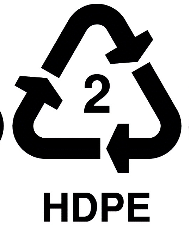 High-density polyethylene |
Yogurt tubs, milk jugs, shopping bags and cups |
|
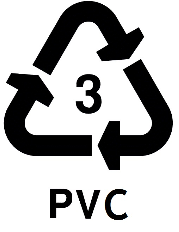 Polyvinyl chloride |
Food packaging and bottles |
|
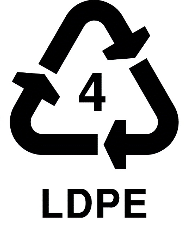 Low-density polyethylene |
Packaging film, shopping bags, six-pack rings |
|
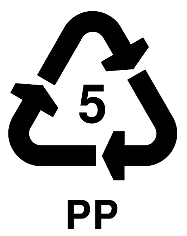 Polypropylene |
Microwave dishes, chip bags, straws |
|
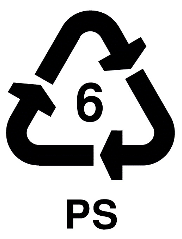 Polystyrene |
Plastic cutlery, hot and cold cups, coffee lids, trays, insulation |
|
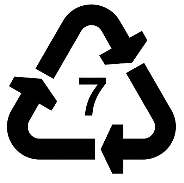 Other |
Multi-layer packaging, food packaging, plastic cutlery, bioplastics |
|
New types of plastic
In the last few years, a range of plastic products have entered the market that are labelled as “compostable,” “bio-based” or “biodegradable.” There is some confusion over how these materials should be used and disposed of because:
- these terms are not used consistently by different manufacturers
- the products frequently require specific recycling or composting processes that are not provided by municipal recycling programs in Canada
If you are interested in using products made with a new type of plastic, it is important to ensure that they will be collected and then recycled or composted after your event. If not properly handled, the new plastic materials can:
- contaminate plastic recycling streams
- result in more plastic waste heading to landfills
Table F2 presents examples of common labels. At this time, most municipal organics collections do not accept compostable or biodegradable plastics, so check with your venue or service provider before purchasing them.
It is important to note that these plastics should be properly disposed of. They:
- generally will not break down in a standard home composting system or in the natural environment
- can contribute to plastic pollution if they are not properly disposed of
| Type of plastic and symbol | How this plastic is used | What can I do with it? |
|---|---|---|
Compostable plastic 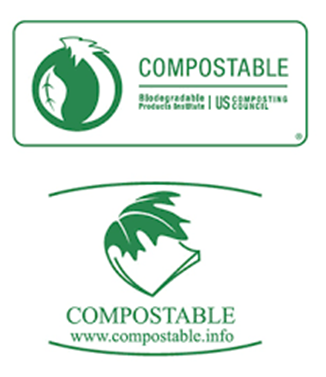

*These are the certifications that are accepted by some facilities in Canada |
Cutlery, takeout containers, lids, shopping bags, garbage bags, travel mugs |
|
Biodegradable plastic 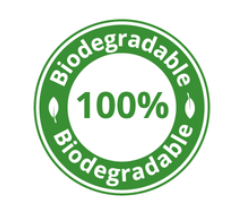

*This is not an exhaustive list of symbols |
Cutlery, takeout containers, lids, shopping bags, garbage bags |
|
Page details
- Date modified: